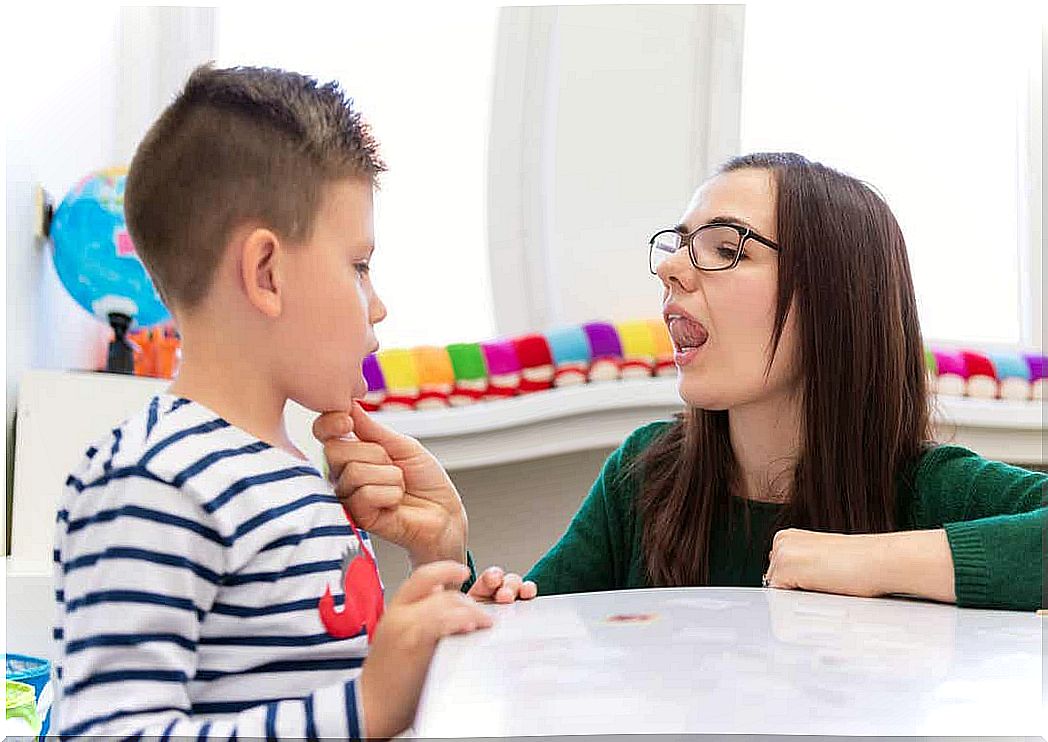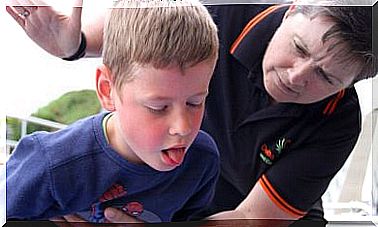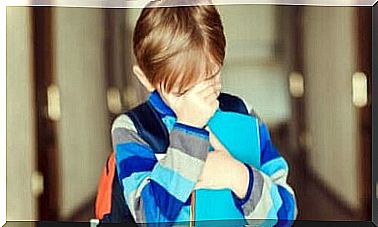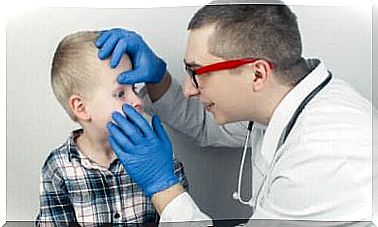Exercises For Atypical Swallowing In Children

Some children may have trouble swallowing because their tongue is not positioned correctly. But by using atypical swallowing exercises, the child can get used to modifying this habit.
Atypical swallowing in children is a change in the way a child swallows that starts when they are small. And if the problem is not corrected, this condition persists into adulthood. Instead of resting it on the palate, the child places their tongue between the upper and lower teeth and applies pressure to it. The rest of the orofacial structures perform compensatory movements, so the problem affects them as well.
The occurrence of other conditions related to this incorrect way of swallowing is common. Open bites, diastemas, protrusions of the front teeth, mouth breathing and difficulty pronouncing some phonemes are some of the associated problems.
Therefore, a correct diagnosis and comprehensive treatment by orthodontists and speech therapists is necessary to solve the problem. In addition, some simple exercises at home can help to re-educate the tongue. Keep reading and learn about these exercises for atypical swallowing in children.
The treatment of atypical swallowing in infants
It is important to correct infant atypical swallowing because of the changes this inappropriate swallowing causes in all orofacial structures. The force of the tongue between the teeth pushes them forward. So it is normal for occlusion problems to arise. In addition, the whole shape of the face changes (Spanish link); speech problems may occur and the habit of breathing through the mouth may develop.

Once the diagnosis has been made and the complexity of the condition has been taken into account, the treatment approach should be interdisciplinary. Orthodontics can correct anatomical and bite problems.
The speech therapist will work on the altered oral functions through re-education and the creation of new muscle movement patterns that facilitate good swallowing. Specific exercises will be used to normalize the practice that has affected the condition.
Exercises for infantile atypical swallowing
We have already mentioned the importance of an integrated treatment (Spanish link) between the orthodontist and the speech therapist to remedy the problem of atypical swallowing in children. It will be this last professional who will determine which exercises and movements are ideal for each clinical case.
Either way, practicing some movements to strengthen the tongue and the structures involved in swallowing can help resolve the problem faster. To be effective, they must be performed slowly, feeling the work of the muscles involved.
Ideally, children should practice them in front of a mirror so they can see what they are working on. Parents should guide their children through the exercises and motivate them to do them. By turning practice time into a playful event, children become more involved in the activities.
As the muscles get stronger and better control the movements, the tongue will begin to position itself correctly. As treatment progresses, the patient will find that the tongue rests relaxed (not pointed) on the palatal ridges and is able to create the seal necessary for swallowing.
Tongue Exercises
Strengthening the intrinsic and extrinsic muscles of the tongue helps to master its movements. Here are some exercises to work with the tongue. They should be practiced little by little, but regularly, up to 3 sets of 15 repetitions:
- Keep the tongue narrow and stick it out of the mouth without touching the teeth.
- Move the tongue up as if you were licking an ice cream without touching the teeth.
- Put the tongue against the roof of the mouth so that it is only possible to breathe through the nose. Open and close the mouth without detaching from the palatal support.
- Stick the tongue outside the mouth and stretch it down as far as you can, trying to see the uvula.
- Stick out the tongue and move it from side to side.
- Make clicks by pressing the tongue against the roof of the mouth and making a sound. This should produce a high-pitched sound.
- Open and close a click pin by pressing it with the tip of the tongue.
- Repeat “cha, cha, cha” and then swallow. Repeat “chu, chu, chu” and swallow.
- Place the tongue in the “n” position, make contact with the upper and lower teeth and swallow without changing the position of the tongue.
- Wear a cereal or piece of bread or wafer on the tip of the tongue and bring it to the “n” position. Hold the food in place, open and close the mouth. This can be done with a lozenge to suck and hold until the candy is completely dissolved.
- Stick your tongue out and in so that you notice the larynx moving up and down (in the mirror you can see the Adam’s apple moving).
Exercises for the buccinator muscle
The buccinator muscle is located on both sides of the face, over the cheeks. During swallowing, it is responsible for moving the food bolus to the tongue to be swallowed.
These are some exercises that help to train it. Ideally, children should perform 3 sets of 15 times:
- Project the lips as if you were giving a kiss.
- Blow up your cheeks and suck in the cheeks.
Exercises for the lip muscles
Working on the strength of the lips in these patients who usually have hypotonic lips is very important. Three sets of 15 reps each are also recommended:
- Squeeze the lips together firmly, without involving the teeth.
- Stretch the upper lip outward, as if massaging the corners of the mouth.
- Hold a plastic spoon with a marble on it between the lips (without involving the teeth) and prevent the marble from falling. You can add up the movement of the marble from one place to another.
- Suck on spaghetti or other food that slides easily between the lips.
- Suck heavy foods, such as yogurt, through straws.
Exercises for chewing and swallowing muscles

During chewing, several muscles are involved that have the function of generating rotating and crushing movements of the food. The masseter, temporalis and buccinators play a very important role.
The isthmus faucium is located in the posterior sector of the mouth and communicates with the buccopharynx. It is also important to work on the pharyngeal and velopharyngeal muscles present there.
Here are some exercises:
- Draw an “o” with the jaw.
- Move the jaw forward and back.
- Chew food in circular motions. Observe yourself in front of a mirror.
- Put a lollipop in the mouth and move it around. Move it from side to side simulating the movement of the food bolus in the mouth.
- Swallow water while smiling and with your mouth open.
- Place a rubber band on the tip of the tongue and try to remove it only with the movements of the tongue, without the intervention of the teeth.
- Position the mouth as if to yawn and force a yawn.
Some more tips for atypical swallowing in children
Paying attention to some aspects of eating will also help correct this habit. It is important, for example, to chew with the molars and mouth closed. In addition, it is important not to move the head or contract the muscles around the mouth while swallowing.
Another factor to consider is the importance of keeping the mouth closed during the day. Also avoid having the tongue between the teeth.
As parents, it is essential to get ahead of these kinds of problems to prevent them from becoming a habit. It is ideal to avoid habits or customs that can favor their appearance.
Regular dental checkups from an early age also make a difference, as this helps identify any problem early and address it promptly, often avoiding damage and consequences that become more serious over time.
And while there are exercises to help correct atypical swallowing in children, as we mentioned, they are not a substitute for professional treatment by speech therapists and orthodontists. A comprehensive treatment is the best solution for this oral condition.









